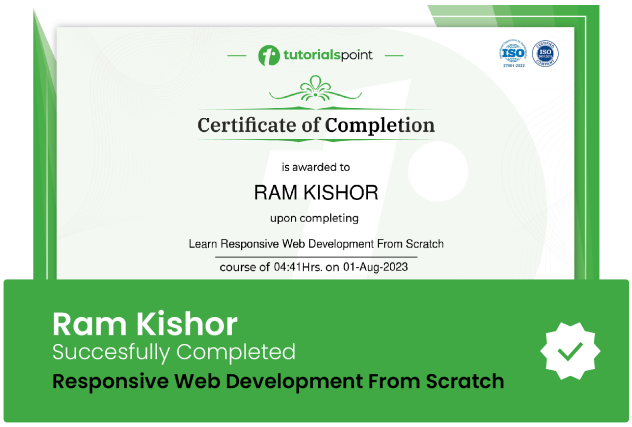The course is generally very good so far. Two points of criticism: please improve your English pronounciation, and please don‘t repeat yourself that much.
The Complete PowerShell 7 Course: Beginner To Advanced
Learn everything about PowerShell 7 in this end-to-end comprehensive online course.

Lectures -146
Duration -12.5 hours

30-days Money-Back Guarantee
Get your team access to 10000+ top Tutorials Point courses anytime, anywhere.
Course Description
PowerShell is an essential tool for system administrators. Get started with the most recent version, PowerShell 7, to kickstart your career and your IT infrastructure.
PowerShell consists of a command-line shell and scripting language that makes up for its task automation and configuration management framework. PowerShell, which is based on the .NET Common Language Runtime (CLR), accepts and returns .NET objects in contrast to the majority of shells, which only accept and return text. This major transformation introduces completely new automation tools and techniques.
PowerShell cmdlets, in contrast to conventional command-line interfaces, are made to work with objects. Structured information that is more than just a series of text on the screen is called an object. Always look for additional information in command output that you can utilize later.
You'll observe that text-processing tools act differently when used in PowerShell if you've previously used them to process data. Text-processing technologies are typically not necessary to extract particular information. By using the typical PowerShell object syntax, you can directly access some of the data.
With its potent combination of a scripting language, command line speed, and GUI features, PowerShell is quickly evolving into the solution that Operators turn to (Graphical User Interface).
The Complete PowerShell 7 Course Overview
In this course, which serves as an introduction to PowerShell, you'll learn how to replace manual, repetitive, and time-consuming tasks with automated ones.
By enrolling, you'll explore the crucial skill of how to use the PowerShell help system and develop the command syntax, giving you a strong foundation in PowerShell and teaching you how to use the program efficiently. The use of commands will then be covered, along with aliases, cmdlets, providers, and psdrives. Ultimately, you'll discover how to customize, use, and maximize the various PowerShell consoles.
You will have advanced your PowerShell proficiency and taken the next step towards PowerShell mastery at the conclusion of this course.
System and network administrators who want to increase the effectiveness of their daily administrative tasks are the best candidates for this training. Whether you have never written a script before or desire the most thorough, sophisticated instruction. You can use PowerShell to jump right to the command line and complete tasks more quickly, consistently, and even repeatedly.
Goals
What will you learn in this course:
Knowing how to use the Powershell command line
Updating and installing Windows PowerShell
To manage and control your Windows computers and servers, learn PowerShell.
Executing and locating commands
Locating and utilizing regional modules
Using files, variables, arrays, and hash tables in programming
Prerequisites
What are the prerequisites for this course?
Basic Computer knowledge.
Windows, Linux, or Mac OS computer
No scripting experience is necessary

Curriculum
Check out the detailed breakdown of what’s inside the course
Introduction To PowerShell
5 Lectures
-
Welcome to This course 02:19 02:19
-
A Brief History of Windows PowerShell 03:44 03:44
-
PowerShell Console Overview 01:49 01:49
-
Discover Windows PowerShell and ISE 04:12 04:12
-
Multiples Ways To Launch Windows PowerShell 02:19 02:19
PowerShell Orientation and Requirements
13 Lectures

PowerShell Modules
9 Lectures

Finding and Discovering Commands
5 Lectures

Interpreting PowerShell Command Help
16 Lectures

PowerShell Alias
5 Lectures

Running Commands in PowerShell
14 Lectures

PowerShell Providers and Drives
11 Lectures

Working with Folders And Files
14 Lectures

PowerShell Variables
13 Lectures

PowerShell Arrays and Hash Tables
7 Lectures

PowerShell Environment Variables
4 Lectures

PowerShell Variable Scripting
4 Lectures

PowerShell Transaction
8 Lectures

PowerShell Operators
17 Lectures

Instructor Details

Fettah Ben
eCourse Certificate
Use your certificate to make a career change or to advance in your current career.

Our students work
with the Best


































Feedbacks
Hello, I really liked the way you thought this course. You made it easy to understand by explaining a lot of the concepts. I will definitely register for your other course: Mastering Windows PowerShell v5.1 & 7, Beginner to Advanced
Related Video Courses
View MoreAnnual Membership
Become a valued member of Tutorials Point and enjoy unlimited access to our vast library of top-rated Video Courses
Subscribe now
Online Certifications
Master prominent technologies at full length and become a valued certified professional.
Explore Now


 Updated on Apr, 2024
Updated on Apr, 2024
 Language - English
Language - English